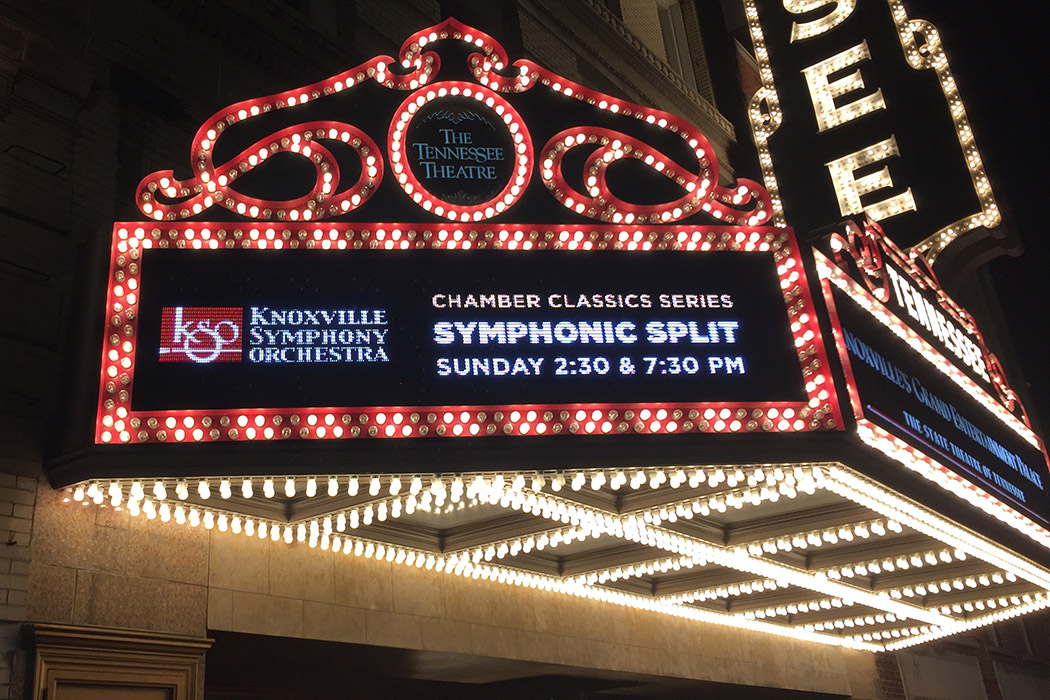Apparently, the universe loves irony. That can be the only explanation for the wildly successful return on Sunday of the Knoxville Symphony Orchestra to performances before live audiences. In a novel approach to conforming to pandemic safety guidelines for both performers and audience, the KSO split a normal two hour concert in the Tennessee Theatre into two one-hour sessions—string works in the afternoon; woodwinds in the evening—with a limited number of audience members at each. While the KSO concerts have been live-streamed since last month, and will continue to be through May, the orchestra has now offered its audience the opportunity to opt-in to a live attendance with pandemic precautions in place. The irony was that those few adventurous listeners who took the leap and attended in person—less than a hundred at each session by my count— witnessed not only stunningly beautiful performances by the orchestra under the circumstances, but also focused performances that luxuriated in an ineffable acoustic clarity in the Tennessee Theatre that is unfortunately muted in normal times when the hall is filled with an audience.
The concert(s) which would have been an item in the KSO’s Chamber Classics Series, had been titled “Symphonic Split” by music director Aram Demirjian. This was an indication of the limitations in safely spacing a quantity of musicians on stage and the issues of including woodwind players who, obviously, cannot be masked. Demirjian’s selection of works for the afternoon and evening reflected that separation and those limitations, but also showcased the tonal qualities that strings and woodwinds possess individually.
One might argue that not only did the necessary eight-foot spacing between musicians have no apparent negative effect on the quality of the orchestra’s ensemble playing, the distance seemed to intensify the musician’s focus. A perfect example of this was Demirjian’s opening choice for the afternoon, J.S. Bach’s Ricercare a 6 from “A Musical Offering” arranged for string orchestra. The work’s rich and complex contrapuntal meandering blossomed for the in-person listeners in a way that probably didn’t show itself to the live-streaming microphones and mixing.
Demirjian took the audience in another direction with a string arrangement of Argentinian composer Astor Piazzolla’s Romance a Diablo. Concertmaster William Shaub took the solo line in this arrangement, capturing the distinct and intricate flavor of the work’s intended bandoneon-like quality.
In pre-pandemic times, I have often described the KSO string sections as having developed a signature “sound” that is a combination of balance and ensemble accuracy. Miraculously, the post-pandemic KSO strings are similarly aligned, with qualities that the final two works on the afternoon program demonstrated. Edvard Grieg’s Holberg Suite had a beautifully balanced lushness, as did the final work, the wonderfully introspective Ralph Vaughn Williams Fantasia on a Theme by Thomas Tallis. For marvelous work throughout the afternoon, it feels necessary to call out the section Principals who all had moments of exposed passagework: violinists Shaub and Edward Pulgar, violist Katherine Gawne, cellist Andy Bryenton, and double bass Steve Benne.
For the evening half of “Symphonic Split,” Demirjian challenged the KSO winds with an ensemble showcase piece, Mozart’s Serenade in B-flat, K 361, “Gran Partita,” a 50-minute work written for 12 woodwinds plus double bass. This performance was a feast of solid sonority and individually lush instrumental colors as the players made the most of the hall’s unencumbered brightness and clarity. Beautifully and accurately rendered, the third movement of seven, an Adagio, was just as described by the character of Salieri in Milos Foreman’s film, Amadeus:
“The beginning… simple, almost comic. Just a pulse – bassoons and basset horns – like a rusty squeezebox. And then suddenly, high above it, an oboe, a single note, hanging there unwavering, until a clarinet took it over and sweetened it into a phrase of such delight! This was a music I’d never heard. Filled with such longing, such unfulfillable longing. It seemed to me that I was hearing the voice of God.”
Eventually, the Tennessee Theatre will once again be filled with audiences that have been forced away for a year by pandemic precautions. But, for one brief day at least, Sunday’s audience had the orchestra to themselves, in a hall alive with clarity, able to sink into an intensely personal experience of music magnificently performed. This was a day and music not to be forgotten.







